什么是 Unraid?
Unraid is an embedded operating system designed to give you complete control over your hardware. It functions as a robust network-attached storage (NAS) system, an application server, and a host for virtual machines (VMs).
Unraid 安装在 USB 闪存驱动器上并从中启动,加载到根 RAM 文件系统中。 它使用了现代 Linux 内核和更新的硬件驱动程序,允许它以最小的内存容量运行在几乎所有 64 位 x86_64 系统上。 操作系统的所有配置数据都存储在闪存驱动器上,并与操作系统同时加载。
Unraid 具有用户友好的 网页界面 ,易于管理。 它为常见任务提供基本控制,为经验丰富的用户提供高级设置。 虽然默认设置适合大多数人,但也允许自定义。 这种简单性和灵活性的结合有效地帮助您存储、保护、共享和享受内容。
Unraid 的核心功能集中在三个主要方面:
软件定义NAS
允许用户高效地在网络上共享存储容量。
阵列和校验
Unraid 提供了一种简单灵活的解决方案,可以将任何支持 64 位的系统转换为网络附加存储 (NAS) 设备。它可以处理各种驱动器,无论是通过 IDE、SATA 还是 SAS 连接,并支持不同的驱动器大小。这意味着您可以随着存储需求的增长逐个添加新驱动器,而无需在扩展设置时重新整理现有数据。
The main job of an Unraid array is to organize and protect the data stored across several drives. It does this by using up to two special drives called parity drives. These parity drives are important because they help reconstruct your data if one of the other drives fails. In fact, with just one parity drive, you can protect all the other drives in your array, keeping your data safe. Plus, you can mix different sized drives and easily expand your storage over time, making Unraid a user-friendly option for anyone looking to manage their data effectively.
校验工作原理 - 点击展开/折叠
In Unraid, parity information is updated in real time. To understand how this works, imagine the contents of a hard drive as a long stream of bits, where each bit is either a zero or a one. By summing the nth bit values across all drives and determining whether that sum is even or odd, the corresponding nth parity bit can be set accordingly. If a data drive ever fails, this parity information allows for an accurate determination of the exact bit values, facilitating a precise rebuild on the replacement drive.
例如:
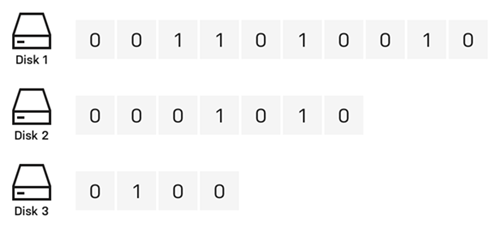
在上面的图像中,三个驱动器包含的比特流因设备大小而异。这些驱动器未被保护,因此如果一个驱动器发生故障,数据将丢失。为防止故障,我们需要第四个磁盘作为 %%parity disk|奇偶校验驱动器%%,其大小必须等于或大于最大的驱动数据盘。
为了设置 %%parity|奇偶校验%% 位,我们找到每列的总和。如果总和为偶数,则 %%parity|奇偶校验%% 位是0;如果为奇数,则 %%parity|奇偶校验%% 位是1。
这是与之前相同的图像,但其中的 %%parity|奇偶校验%% 是根据每个帧计算的:
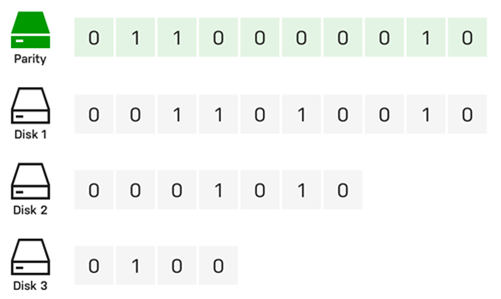
假设我们的例子中磁盘2出现故障,并购买了新磁盘来替换它:
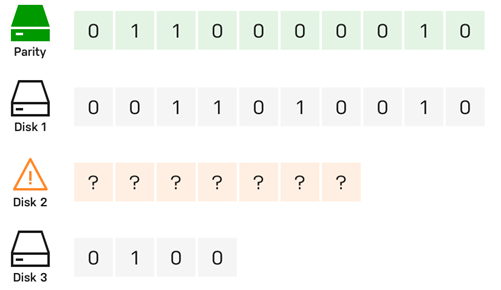
要在新磁盘上重建数据,我们确定缺失的位,而不是计算 %%parity|奇偶校验%% 位。对于第1列,总和是0,所以缺失的位是0。对于第6列,总和是1, 所以缺失的位是1。
使用 %%parity|奇偶校验%% 重建磁盘可防止数据丢失并提供容错能力,即使驱动器故障仍确保系统的完全访问。
用户份额
Unraid 的不同之处在于,它将数据保存在单个驱动器上,而不是将它们合并成一个驱动器。作为 %%root user|root 用户%%,您可以创建 %%user shares|用户共享%%,它们就像顶级文件夹,收集 %%array|阵列%% 或 %%cache pool|缓存池%% 中多个驱动器上的文件。这意味着您不必担心哪个特定驱动器存储您的文件;它们已为您整理好。
您还可以自定义这些共享以包含或排除某些驱动器,并决定如何将文件分布在存储中。此外,您可以通过设置网络选项来管理用户如何访问共享,例如 SMB 和 NFS ,并应用安全设置。为了保障私人数据安全,您可以创建用户账户并为可信个体设置访问限制。
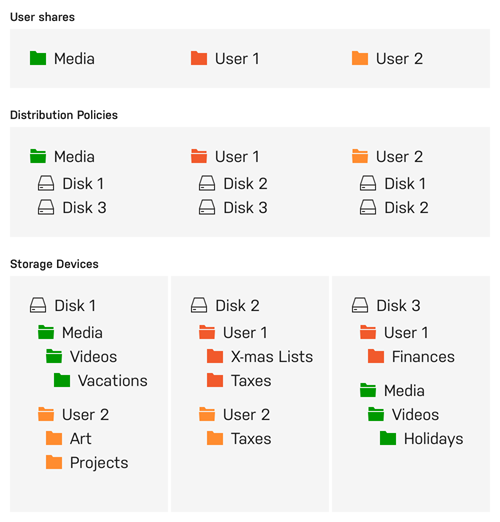

理解缓存驱动器
Unraid 的一大突出特点是 %%cache drive|缓存%%,可以加快数据传输速度。当您在三台或更多驱动器旁边使用 %%cache drive|缓存%% 时,数据写入速度可提高高达三倍。当您将文件保存到使用 %%cache drive|缓存%% 的 %%user shares|用户共享%% 时,数据首先储存在 %%cache drive|缓存%% 上。这允许快速写入,然后一个称为 %%Mover|搬运者%% 的过程将数据传输到主存储 %%array|阵列%% 中——通常在晚上——为 %%cache drive|缓存%% 腾出空间。
为了增强数据安全性,您可以设置具有多个驱动器的 %%cache pool|缓存池%%。这种设置不仅可以增加存储空间,还可以使用 %%ZFS|zfs%% 或 %%BTRFS|btrfs%% 提供类似 %%RAID 1|raid1%% 的额外数据保护。总体而言,Unraid 的共享和 %%cache drives|缓存%% 管理方案提供了灵活、高效且安全的存储解决方案。
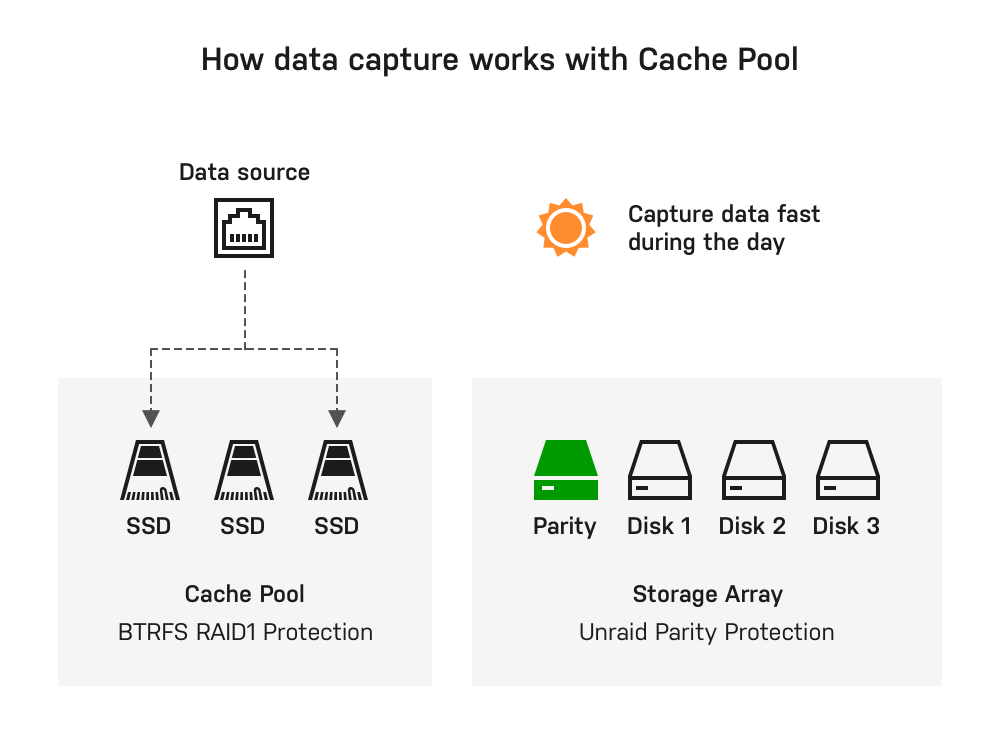
应用程序服务器
支持容器化应用程序的执行。
Unraid 通过 Docker 容器技术将您的存储解决方案变成多功能 %%application server|应用服务器%%。这种方法克服了传统 NAS 的局限性,同时保持系统稳定性和易用性。
传统的NAS解决方案在应用程序托管方面面临三个关键挑战:
- 操作系统兼容性问题 - 无法运行为不同操作系统设计的应用程序。
- 复杂的生命周期管理 - 困难的安装体验可能会在删除后留下残留物。
- 应用程序冲突 - 软件组件可能会干扰彼此或系统操作。
Unraid 使用Docker通过以下三种关键方式解决这些挑战:
- 操作系统独立性 - 每个容器在自己的Linux环境中运行,消除了与主操作系统的兼容性问题。
- 基于映像的部署 - 预配置的应用程序包允许一键安装和完全卸载应用程序。
- 进程隔离 - 容器化应用程序在单独的用户空间中运行,防止软件之间的任何冲突。
Docker 容器允许您在隔离、轻量的环境中运行应用程序,而不需承担 %%virtual machines|虚拟机%% 相关开销。Unraid 通过 Docker Hub 和 Community Applications 提供的预配置应用程序,简化了 Docker 的使用。这种容器化方法使 Unraid 用户能够同时运行多个应用程序而不会有兼容性问题。它还通过使用独立的应用程序包帮助保持系统有序,并便于通过 Docker 的生态系统增强服务器功能。
有关高级 Docker 设置,请查看 Run Docker Containers。
虚拟化平台
允许以接近裸机硬件的性能运行虚拟机。
Unraid 作为虚拟化主机运作,通过使用 %%hypervisor|虚拟机管理程序%% 安全分配资源给虚拟化的客户环境。这使您能够在隔离环境中运行各种应用程序,而不仅仅是网络附加存储。
要在 Unraid 中使用硬件虚拟化,请确保您的 CPU、芯片组、BIOS 和设备驱动程序兼容。完整的要求列表可在 VM setup guide 中找到。如果您的服务器不符合这些要求,Unraid 的 %%VMs|虚拟机%% 菜单将会在 %%WebGUI|WebGUI%% 中禁用。
使用虚拟机的好处 - 点击展开/折叠
虽然 Docker 容器在基于 Linux 的应用程序中很受欢迎,虚拟机 提高了 Unraid 服务器设置的灵活性和效率,并为您的 Unraid 服务器提供了显著优势:
-
隔离:VMs在独立的环境中运行,确保其中一个失败不会影响其他。
-
整合: 将多个物理服务器整合到一台 Unraid 机器上,减少硬件需求,简化维护。
-
资源分配: Unraid 允许您为每个 虚拟机 分配特定的 CPU、内存、存储和网络资源,以确保关键任务获得必要的资源。
-
测试与开发:VMs允许轻松创建和测试软件在不同环境中的运行,而不需要多台物理机器。
-
安全:VMs的隔离增强了安全性,使恶意软件很难在它们之间传播。
-
遗留应用程序支持:VMs允许您运行可能与现代硬件不兼容的遗留应用程序或操作系统。
-
**资源过度承诺:**您可以运行比通常的物理资源允许的更多VMs,理解到并非所有资源会同时完全利用它们的分配。
用于虚拟化的可分配设备支持 - 点击展开/折叠
Unraid's KVM-based virtualization uses modern tools for flexible hardware assignment while maintaining host stability.
主要组件包括:
核心技术
分配资源
- 计算: 通过 CPU pinning 绑定专用 CPU 核心。
- 内存: 隔离的内存。
- 存储: 通过 VirtIO 优化的 SSD 虚拟磁盘。
- 外设: 全 PCI/USB 设备直通,包括 GPU passthrough 支持。
平台灵活性
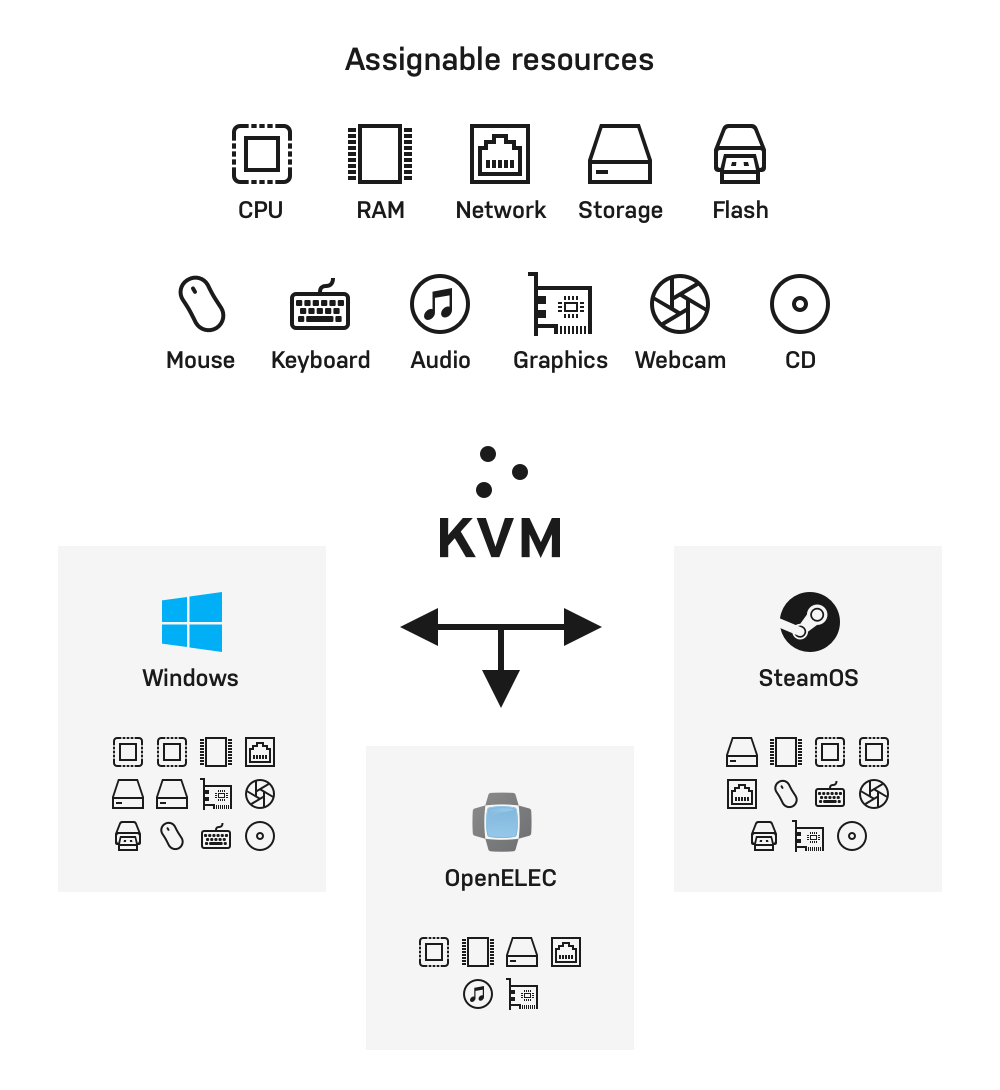
%%GPU passthrough|GPU直通%% 需要兼容的硬件(参见 VM setup)。